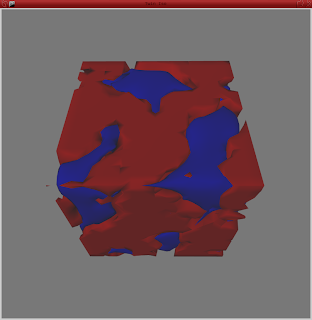- The building of a multi-dimensional array in ruby
- The casting of a multi-dimensional ruby array to a java array of float[][]
- Using "each" with a java iterator (it is so easy)
- Using bit shifting to create a color int
- Using the PShape vbo object
- A rubified do while block
load_libraries :hemesh, :vbo include_package 'wblut.math' include_package 'wblut.processing' include_package 'wblut.core' include_package 'wblut.hemesh' include_package 'wblut.geom' RES = 20 attr_reader :mesh_ret, :inv_mesh_ret, :render def setup size(800, 800, P3D) smooth(8) values = [] # build a multi-dimensional array in ruby (0 .. RES).each do |i| # the inclusive range is intentional here valu = [] (0 .. RES).each do |j| val = [] (0 .. RES).each do |k| val << 2.1 * noise(0.35 * i, 0.35 * j, 0.35 * k) end valu << val end values << valu end creator = HEC_IsoSurface.new creator.set_resolution(RES,RES, RES) # number of cells in x,y,z direction creator.set_size(400.0/RES, 400.0/RES, 400.0/RES) # cell size # JRuby requires a bit of help to determine correct 'java args', particulary with # overloaded arrays args as seen below. Note we are saying we have an 'array' of # 'float array' here, where the values can also be double[][][]. creator.set_values(values.to_java(Java::float[][])) # the grid points creator.set_isolevel(1) # isolevel to mesh creator.set_invert(false) # invert mesh creator.set_boundary(100) # value of isoFunction outside grid # use creator.clear_boundary to set boundary values to "no value". # A boundary value of "no value" results in an open mesh mesh = HE_Mesh.new(creator) # mesh.modify(HEM_Smooth.new.set_iterations(10).setAutoRescale(true)) creator.set_invert(true) inv_mesh = HE_Mesh.new(creator) inv_mesh.modify(HEM_Smooth.new.set_iterations(10).set_auto_rescale(true)) @render = MeshToVBO.new(self) no_stroke # no color args produces a default light grey fill @mesh_ret = render.meshToVBO(mesh, color(200, 0, 0)) @inv_mesh_ret = render.meshToVBO(inv_mesh, color(0, 0, 200)) end def draw background(120) lights define_lights translate(400, 400) rotate_y(mouse_x.to_f / width * TWO_PI) # use TWO_PI until processing-2.0b9 rotate_x(mouse_y.to_f / height * TWO_PI) # then we can use TAU shape(inv_mesh_ret) shape(mesh_ret) end def define_lights ambient(20, 20, 20) ambient_light(60, 60, 60) point_light(30, 30, 30, 0, 0, 0) directional_light(40, 40, 50, 1, 0, 0) spot_light(30, 30, 30, 0, 40, 200, 0, -0.5, 0.5, PI / 2, 2) end
Here is the mesh to vbo library
# mesh_to_vbo.rb module MS include_package 'java.util' include_package 'processing' include_package 'processing.core' include_package 'wblut.geom' include_package 'wblut.hemesh' end class MeshToVBO include Processing::Proxy include MS attr_reader :parent def initialize(parent) @parent = parent end def meshToVBO(mesh, col = nil) tri_mesh = mesh.get tri_mesh.triangulate retained = parent.create_shape retained.begin_shape(TRIANGLES) if col retained.fill(col) else # we will have a light grey color, created by bit shifting fcol = (255 >> 24) & 0xFF|(211 >> 16) & 0xFF|(211 >> 8) & 0xFF|211 retained.fill(fcol) end retained.ambient(50) retained.specular(50) mesh.fItr.each do |face| # call each on the hemesh mesh iterator he = face.getHalfedge begin # this block is the ruby equivalent of do while vx = he.getVertex vn = vx.getVertexNormal retained.normal(vn.xf, vn.yf, vn.zf) retained.vertex(vx.xf, vx.yf, vx.zf) he = he.getNextInFace end while (he != face.getHalfedge) end retained.end_shape return retained end end


No comments:
Post a Comment